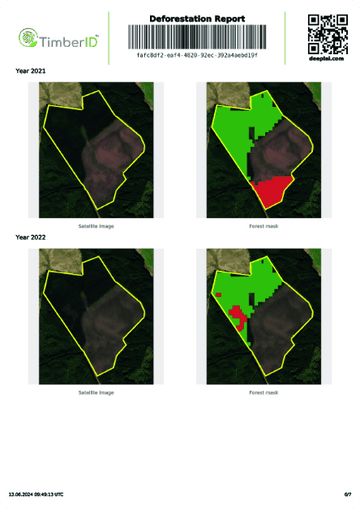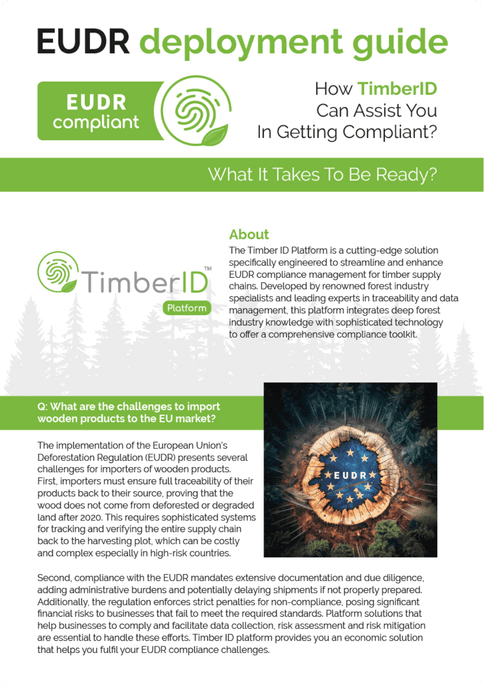Why TimberID?
Why TimberID?
A solution designed to fit your business — without compromise.
Licence fees adjusted to your business size — fair and affordable.
No hidden fees — includes:
 Unlimited users and supplier profiles.
Unlimited users and supplier profiles. Fast 1-day setup.
Fast 1-day setup. API integration support for your ERP systems.
API integration support for your ERP systems.
Achieve compliance effortlessly with TimberID:
 Seamlessly export compliance datasets to external systems.
Seamlessly export compliance datasets to external systems. Automated data transfer powered by TimberID's decentralized architecture.
Automated data transfer powered by TimberID's decentralized architecture.
Licence fees adjusted to your business size — fair and affordable.
No hidden fees — includes:
Achieve compliance effortlessly with TimberID:

Take Advantage of a Free Consultation and Find Out:
 Navigate the EUDR implementation process
Navigate the EUDR implementation process Meet documentation and compliance requirements
Meet documentation and compliance requirements Automate processes with TimberID
Automate processes with TimberID
Platform Presentations
Platform Presentations

EUDR key challenges:
 What are the potential benefits and opportunities associated with implementing sustainable practices in your company?
What are the potential benefits and opportunities associated with implementing sustainable practices in your company? How do you source, verify information in your due diligence process?
How do you source, verify information in your due diligence process? How do you convey information to stakeholders in the supply chain?
How do you convey information to stakeholders in the supply chain? How can due diligence processes be streamlined and facilitated and suppliers effectively monitored through the entire chain down to the source to ensure compliance?
How can due diligence processes be streamlined and facilitated and suppliers effectively monitored through the entire chain down to the source to ensure compliance? What measures should be taken to track harvested timber with accurate geo-location and obtain evidence of deforestation and compliance status of each supplier throughout the supply chain?
What measures should be taken to track harvested timber with accurate geo-location and obtain evidence of deforestation and compliance status of each supplier throughout the supply chain? How can risks associated with non-compliance with EUDR obligations be mitigated and prevented?
How can risks associated with non-compliance with EUDR obligations be mitigated and prevented?
SaaS Platform




SaaS Platform
Effective implementation of the EUDR requirements:




SaaS Platform
Effective implementation of the EUDR requirements:
The TimberID solution is globally available through a SaaS platform.
Electronic Delivery Note (eDN)
Streamlined Supply Chain Traceability
Streamlined Supply Chain Traceability
The system supports legal sourcing, full supply chain transparency, and compliance.Powered by TimberID, eDNs help businesses streamline supply chain management with confidence.
The system supports legal sourcing, full supply chain transparency, and compliance.Powered by TimberID, eDNs help businesses streamline supply chain management with confidence.
Risk Mitigation Templates

Predefined, fully customisable templates for risk assessment and mitigation - applied consistently at the plot, supplier and delivery levels.
This structured approach enables:
Collecting reliable and verifiable due diligence documentation.
Performing and documenting audits across the supply chain.

Predefined, fully customisable templates for risk assessment and mitigation - applied consistently at the plot, supplier and delivery levels.
This structured approach enables:
Collecting reliable and verifiable due diligence documentation.
Performing and documenting audits across the supply chain.
Satellite Imagery Deforestation Analysis



TimberID Deforestation Report structure:



TimberID Deforestation Report structure:
EUDR implementation guide

EUDR implementation guide
How does the TimberID Platform support processes in achieving compliance?
What actions need to be taken?
Download EUDR implementation guide and learn more.
What actions need to be taken?
Download EUDR implementation guide and learn more.

Empower your team
with the EUDR Institute
certification
with the EUDR Institute
certification
Empower your team
with the EUDR Institute
certification
with the EUDR Institute
certification
Prepare your team to successfully navigate and comply
with the European Union Deforestation Regulation (EUDR)
through our specialized training programs.
with the European Union Deforestation Regulation (EUDR)
through our specialized training programs.
EUDR Institute certification

Sustainably managed forests and wood products play a crucial role in addressing the climate crisis.
By choosing the Timber ID platform, you are actively supporting sustainable and eco-friendly forest management practices.
A clearer view of your supply chain also empowers you to more effectively understand and reduce your own carbon footprint TimberID, captures all essential delivery data to ensure legal sourcing, full traceability, and compliance.

Need more information?
For additional information please
All trademarks, service marks, trade names, product names, logos and trade dress appearing on our website are the property of their respective owners. "AWS", "Amazon Web Services", "Powered by AWS" logo are trademarks of Amazon.com, Inc. or its affiliates in the United States and/or other countries. NVIDIA, the NVIDIA logo, and all other NVIDIA product names mentioned in this website are trademarks and/or registered trademarks of NVIDIA Corporation in the U.S. and other countries. Apple, the Apple logo, MacBook Air, MacBook Pro, and iMac are trademarks of Apple Inc., registered in the U.S. and other countries. Mac App Store is a service mark of Apple Inc.
